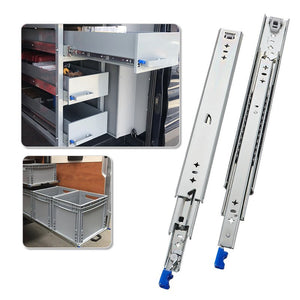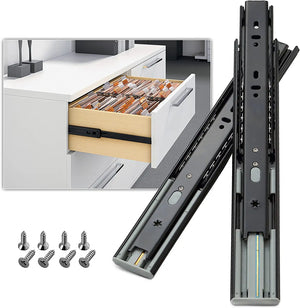I. Introduction
File cabinet drawers, although steadfast in their duty, occasionally require removal for various reasons, each contributing to the overall maintenance and functionality of the storage unit.
One common motivation for removing file cabinet drawers is the need for reorganization. Over time, the contents within drawers may evolve, and the initial arrangement might no longer suit the current organizational needs. By temporarily removing the drawers, individuals can reassess and optimize the internal space, ensuring a more efficient and tailored storage solution.
Another compelling reason for drawer disassembly is drawer malfunction.In cases where a drawer malfunctions, removal becomes imperative for troubleshooting and replacement. Whether the issue lies with the slides, tracks, or the drawer itself, taking it out of the cabinet provides a closer inspection and facilitates the necessary repairs or replacement. This ensures the longevity of the entire filing system.
During office relocations or furniture rearrangements, the need to transport file cabinets may arise. Removing the drawers not only makes the cabinets lighter and easier to maneuver but also reduces the risk of damage during transportation. It's a practical step to ensure the integrity of the drawers and the overall cabinet structure.
Understanding the diverse reasons for removing file cabinet drawers emphasizes their dynamic role in our organizational endeavors. Whether driven by the need for a cleaner space, a functional upgrade, or a personal touch, the process of removal is a versatile solution to cater to the evolving demands of users.

II. Tools Required for the Task
Embarking on the journey of removing file cabinet drawers requires a set of essential tools to ensure a smooth and efficient process. Whether you are a DIY enthusiast or a novice in the world of furniture maintenance, having the right tools at your disposal is crucial for a successful drawer removal.
Basic Tools for File Cabinet Drawer Removal

1. Screwdriver Set:
- Purpose: Used to remove screws securing the drawer to the slides or tracks.
- Tip: Ensure the screwdriver set includes various types and sizes to accommodate different screw heads.
2. Adjustable Wrench:
- Purpose: Useful for loosening and tightening nuts and bolts, particularly those securing the slides.
- Tip: Choose an adjustable wrench to accommodate various nut sizes.
3. Rubber Mallet:
- Purpose: Allows for gentle tapping to dislodge any stuck or stubborn parts without causing damage.
- Tip: Opt for a rubber mallet to minimize the risk of marring the furniture.
4. Pliers:
- Purpose: Useful for gripping and extracting stubborn screws, especially in cases of rust or corrosion.
- Tip: Keep both needle-nose and regular pliers handy for versatility.
Specialized Tools for Precision
1. Screwdriver Set:
- Purpose: Facilitates the quick and easy release of drawer glides or slides.
- Tip: Check the compatibility of the clips with the specific type of drawer slides.

2. Furniture sliders:
- Purpose: Helps in smoothly sliding the drawer out of the cabinet without scratching or damaging the floor.
- Tip: Place furniture sliders under the cabinet to ease the sliding process.

3. Cordless Drill:
- Purpose: Speeds up the process of removing screws, especially in larger cabinets with multiple drawers.
- Tip: Ensure the drill has a variable speed setting for precision control.
4. Drawer Removal Jig:
- Purpose: Provides additional support and guidance during the removal process.
- Tip: Choose a jig compatible with the specific dimensions and design of the file cabinet.
Safety Gear for a Secure Task

1. Safety Glasses:
- Purpose: Protects the eyes from dust, debris, or accidental splinters during the removal process.
- Tip: Opt for safety glasses with side shields for comprehensive protection.
2. Work Gloves:
- Purpose: Shields the hands from sharp edges, splinters, or any potential hazards.
- Tip: Choose durable work gloves that provide both protection and flexibility.
In the upcoming sections, we'll explore the step-by-step process of removing file cabinet drawers, highlighting the specific use of these tools for a hassle-free experience.
III. Step-by-Step Guide to Remove File Cabinet Drawers
Removing file cabinet drawers may seem like a daunting task, but fear not—we've crafted a detailed step-by-step guide to demystify the process. Whether you're rearranging your office space or performing maintenance, following these comprehensive steps will ensure a smooth and hassle-free experience.
Preparing for Success

1. Clear the Surrounding Area:
- Purpose: Create a clutter-free zone around the file cabinet to ensure easy access and movement during the removal process.
- Tip: Remove any items on top of the cabinet and clear the floor space.
- Detailed Procedure: Clear the workspace around the file cabinet, removing any objects on top and ensuring there's ample space to maneuver.
2. Gather Essential Tools:
- Purpose: Having the right tools on hand is crucial for a successful drawer removal.
- Recommended Tools: Screwdriver set, adjustable wrench, rubber mallet, pliers, and safety gear.
- Detailed Procedure: Gather the necessary tools, ensuring they are in good condition and ready for use.
3. Familiarize Yourself with the Drawer Slides:
- Purpose: Understanding the type of drawer slides used in your cabinet will guide the removal process.
- Tip: Consult the cabinet or drawer manual if available.
- Detailed Procedure: Examine the drawer slides carefully, noting any release mechanisms or levers.
The Step-by-Step Process

Step 1: Empty the Drawer:
- Purpose: Remove all contents from the drawer to reduce weight and facilitate easier handling.
- Tip: Use this opportunity to declutter and organize documents or office supplies.
- Detailed Procedure: Remove all items from the drawer, placing them in a secure location.
Step 2: Examine the Drawer Slides:
- Purpose: Identify the type of slides—side-mount, bottom-mount, or other—used in the cabinet.
- Tip: Look for release mechanisms or levers that may be present.
- Detailed Procedure: Inspect the drawer slides and identify any visible release mechanisms.

Step 3: Locate Release Mechanisms:
- Purpose: Some drawers have release clips or levers that need to be engaged before removal.
- Tip: Gently pull the drawer while pressing or lifting any visible release mechanisms.
- Detailed Procedure: If present, engage the release mechanisms as you gently attempt to pull the drawer.

Step 4: Remove Screws or Bolts:
- Purpose: Using the appropriate tools, loosen and remove screws or bolts securing the drawer slides to the cabinet.
- Tip: Have a container to keep screws organized and prevent loss.
- Detailed Procedure: Use the screwdriver or wrench to carefully remove the screws or bolts securing the drawer slides.
Step 5: Apply Gentle Pressure:
- Purpose: If the drawer is stuck, apply gentle pressure while wiggling it side to side to dislodge any obstructions.
- Tip: Use a rubber mallet for stubborn cases, tapping lightly on the sides.
- Detailed Procedure: If the drawer resists, apply gentle pressure while attempting to wiggle it back and forth.

Step 6: Slide the Drawer Out:
- Purpose: Once all securing mechanisms are disengaged, smoothly slide the drawer out of the cabinet.
- Tip: Hold the drawer from both sides to maintain balance during removal.
- Detailed Procedure: With all obstacles removed, slide the drawer out smoothly, ensuring it remains level.
Safety First
1. Use Safety Gear:
- Purpose: Protect yourself with safety glasses and work gloves to prevent injuries during the removal process.
- Tip: Prioritize safety, especially when dealing with heavy drawers or unfamiliar mechanisms.
- Detailed Procedure: Put on safety glasses and work gloves before initiating the removal process.
2. Secure Heavy Drawers:
- Purpose: For drawers with substantial weight, have a second person assist in the removal process to avoid strain or accidents.
- Tip: Communicate clearly and work together to ensure a safe removal.
- Detailed Procedure: If the drawer is heavy, enlist the help of a second person to assist in a controlled and safe removal.
By following these detailed steps and taking the necessary precautions, you'll successfully remove file cabinet drawers without stress or complications.
IV. Maintenance Tips: Ensuring Longevity
Drawer slides play a crucial role in the functionality of your furniture, and proper maintenance is key to ensuring their longevity. Follow these practical tips to keep your drawer slides in optimal condition, preventing wear and tear while enjoying smooth, hassle-free operation.
Regular Cleaning and Inspection

1. Gentle Cleaning Routine:
- Purpose: Dust, dirt, and debris can accumulate over time, affecting the performance of your drawer slides.
- Tip: Use a soft brush or cloth to gently remove any particles from the slides.
- Detailed Procedure: Regularly clean the slides with a soft brush or cloth, paying attention to corners and crevices.
2. Lubrication for Smooth Operation:
- Purpose: Lubrication reduces friction, allowing the drawer slides to move effortlessly.
- Tip: Choose a silicone-based or dry lubricant for minimal residue.
- Detailed Procedure: Apply a thin layer of lubricant to the slides, focusing on the moving parts.
3. Regular Inspection:
- Purpose: Detecting issues early prevents further damage and ensures timely repairs.
- Tip: Check for misalignments, loose screws, or any signs of wear during inspections.
- Detailed Procedure: Periodically inspect the slides, looking for any abnormalities or loose components.
Seasonal Adjustments

1. Accounting for Temperature Changes:
- Purpose: Wood expands and contracts with temperature fluctuations, impacting the alignment of drawers.
- Tip: Make seasonal adjustments to account for temperature-related shifts.
- Detailed Procedure: Check and adjust the alignment of drawers during temperature changes to prevent sticking or misalignment.
2. Tightening Loose Screws:
- Purpose: Loose screws can compromise the stability of drawer slides.
- Tip: Tighten screws gently to avoid stripping or damaging the material.
- Detailed Procedure: Regularly check and tighten any loose screws on the drawer slides.
3. Addressing Humidity Challenges:
- Purpose: High humidity can lead to wood swelling, affecting the smooth movement of drawers.
- Tip: Use a dehumidifier in humid conditions to maintain an optimal environment.In addition, you also need stainless steel anti-corrosion slide rails to prevent your drawer from being pulled out smoothly.
- Detailed Procedure: Replace ordinary drawer slides with stainless steel drawer slides to improve the corrosion resistance of the drawer. Use a dehumidifier regularly to keep the environment free of moisture.

Handling Heavy Loads and Overextension
1. Stay Within Weight Limits:
- Purpose: Exceeding weight limits can strain and damage drawer slides.
- Tip: Refer to the weight capacity specifications and avoid overloading drawers.If the load-bearing capacity is not enough, consider replacing heavy-duty drawer slides
- Detailed Procedure: Be mindful of weight limits and distribute heavy items evenly across drawers.If necessary, you can replace the heavy-duty drawer slides to increase the load-bearing capacity. In addition, the pull-out length of the slide rails will also affect its load-bearing capacity. The longer the pull-out size, the weaker the load-bearing capacity.
2. Avoid Overextension:
- Purpose: Pulling drawers too far can cause strain and lead to premature wear.
- Tip: Use drawer stops or limiters to prevent overextension.
- Detailed Procedure: Install stops or limiters to control the extension of drawers and prevent strain on the slides.
VI. Conclusion: Empowering Users
As we conclude this comprehensive guide on drawer slide maintenance, it's evident that prioritizing the care of these seemingly small components can significantly impact the functionality and longevity of your furniture. By adopting a proactive approach to maintenance, you empower yourself to create a smoother, more enjoyable experience in your daily life.
In the realm of home and furniture care, every detail matters. Drawer slides, often overlooked, play a pivotal role in the daily rhythm of our lives. Through regular care and informed decision-making, users have the ability to transform their living spaces, making them not only functional but also aesthetically pleasing.
By adopting the practices outlined in this guide, users can unlock the full potential of their furniture, ensuring it stands the test of time. As we navigate the intricacies of drawer slide maintenance, let us embrace the empowerment that comes with knowledge, transforming our living spaces into havens of comfort and functionality.





